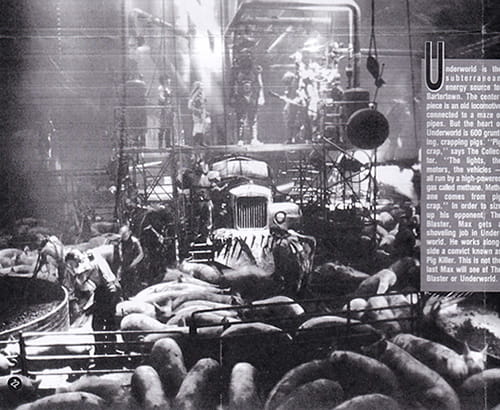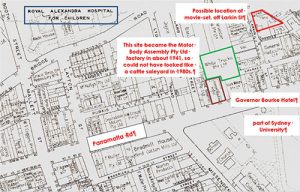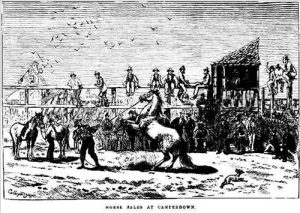The Glebe Society frequently receives requests for information via its website and Facebook page, to assist people in their family history research or to better understand the history of their house. But, once in a while, a request of far-reaching significance comes in – such as this one from France-based Melvin. Melvin (if my high school French serves me correctly), studied at the Sorbonne and now lives in Silverton NSW – that’s about 25km west of Broken Hill. I hazard a guess that Melvin is Silverton’s only resident who had attended the Sorbonne – if not its only resident.
Melvin writes:
Hello, I’m searching information about a place used for a movie location in 1984. It was, at the time, a disused cattle sale ring near Parramatta Rd. It should have been between an hospital and a hotel, maybe named ‘White Horse’ (but I’m not sure). Does it ring any bells? I’m desperately searching the location for a writing project. I’m from France so it’s not very easy to make some research about that. Regards, Melvin
The film to which Melvin refers is Mad Max: Beyond Thunderdome. For anyone who has been under a rock for the last 40 years, Mad Max is a series of Australian post-apocalyptic / dystopian action films, made between 1979 and 2015. The Mad Max films were created by director George Miller and producer Byron Kennedy (Wikipedia). Mad Max Beyond Thunderdome (1985), is the third in the series.
In case you, like me, have no idea of Mad Max’s origin story, Max Rockatansky was a law-abiding young policeman with the highway patrol unit who turned rogue after his son, Sprog, was killed by Toecutter and his gang of baddies. This takes place in the first film, after which Mad Max’s no-holds-barred approach to conflict resolution leads him on all sorts of adventures in the remaining three films. (I admit to getting this information from Wikipedia, as I had failed miserably to follow the plot-line during the film’s screening at Manning Bar in 1982, having consumed a considerable number of schooners of new.)
The scene of interest to our French friend takes place in Underworld, which is where pigs live who give off methane to power Barter Town (or Bartertown, depending on your source). For some reason that can probably only be determined by actually watching the film, Max (Mel Gibson) wants to go to the Underworld, which he decides to do after looking through a periscope with Frank Thring and Tina Turner.

In a quaint – if now dated – exchange between Frank Thring and Mad Max, Frank explains that the pigs produce a ‘high-powered gas called methane. And methane cometh from pig shit.’ To my great surprise, Max had never heard of methane. He was, however, more au fait with shovelling ‘pig shit’, which was his entrée to the Underworld.
The pigs in question can be seen in this video clip on YouTube. I’m sure you’ll be pleased to know that, after an imaginative battle scene in which Max vanquishes Blaster (the big half of ‘Master Blaster’ – long story, don’t ask), Mel Gibson escapes largely unharmed with the assistance of George from Play School.
Lest you get the impression that the Glebe Society is stooping to a new low by considering a popular culture action movie, we will provide an alternative interpretation of this film and its location within an, arguably, automotive dystopian genre.
Claire Corbett explains in the abstract for an academic article entitled Nowhere to Run: Repetition Compulsion and Heterotopia in the Australian Post-Apocalypse – from ‘Crabs’ to Mad Max beyond Thunderdome, that such films offer
a compressed and symbolic meditation on elements of Australian history that have shaped the psyche of Australian settler society, and which are projected into a dystopian future. … I look at how these elements are elaborated in the Mad Max films and suggest that this particular type of story arises from the first global oil shocks of the early 1970s onwards as a recognisably Australian genre of unreal nihilist automotive dystopia, an aspect of a broader metaphor of Australian society and governance characterised as ‘the petrochemical, chrome-plated cyborg republic of Oz’.
Fortunately, I was unable able to read the full article as it was behind a journal paywall. But I digress.
As is the usual practice, the enquiry was put to the members of our Management Committee and the Heritage Subcommittee. One committee member felt sure that the said cattle yards were at Homebush; the old Homebush saleyards, now the Sydney Olympic site. One thought they were located on, or near, the grounds of the University of Sydney because the head of the Veterinary Science Department at the time was a pig expert who had been a consultant to the film production unit (the smoking gun??). Another replied that the brick pit at Homebush was a possible location for the scene, because the Horse and Jockey Hotel on Parramatta Rd (one of the watering holes for under-age drinkers at his school at nearby Strathfield) was nearby and could easily be confused with the White Horse Hotel.
The question then became – for the Homebush Bay theory to hold water – ‘Where is the hospital?’ Teamwork now kicked in:
I don’t know, and suggest the best approach is to find maps of that vintage because almost all of the area was bulldozed and remade with the Olympics development for 2000. The Mad Max movie was called Beyond Thunderdome and the production company’s location scout might be a useful informant.
To which a reply came in:
Here’s a link to a 1951 map. Can’t see a hospital, but maybe someone has sharper eyes than me. Or perhaps it is in the White Horse Hotel category. (ie not where our Frenchman thought it to be).
Then, in support of the theory about a location closer to home, someone recalled that
there was a White Horse Hotel in Newtown that the preppy college boys used to go to – 27 King St. RPA is close (as the crow flies, or as pigs might fly) and the vet science buildings are not too far away, but you wouldn’t say they’re between them. The only hospital I can think of to support the Homebush hypothesis is the old Lidcombe Hospital, but that’s about 4km from Parramatta Rd.
Then –
I might have found them! I think it was the Camperdown saleyards! Articles in Trove say it adjoined the Governor Bourke pub which you can see in the attached map. You can see that the location fits the description fairly well.
Another contributor, after a bit of ‘digging’ (pun intended), provided a link to a 2015 archaeological survey report on a nearby development site (off Barr St). While the contributor is to be commended for her use of high-quality sources, alas, though close, the site was not our elusive pig pen.

On balance, support was shifting away from the Homebush hypothesis and towards a Glebe/Camperdown hypothesis. After further research, Rodney Hammett from the Heritage Subcommittee proposed that the hospital was (of course!) the Royal Alexandria Hospital for Children, now redeveloped as the City Quarter, a large residential complex. Rodney concluded:
On weighing up all the evidence and after poring over old maps it is most likely the movie-set was in the old horse yards off Larkin St in Camperdown – see 1950s City of Sydney map below.
As for the putative White Horse Hotel? Well, that was gone by the time the film was made. Rodney again:
The hotel near the Mad Max set was the Governor Bourke on Parramatta Rd, which must have been visited for its convenience. The White Horse hotel on King St, Newtown, now part of Moore Theological College, closed in 1981/82, however might have been visited prior to then and remembered fondly for its unique atmosphere.
[Since this article was written, its come to our attention that the White Horse Hotel, on closing down in Newtown, relocated to Parramatta Road, Camperdown, about 100 metres along from the Student Prince Hotel. Neither hotel still exists. According to Glenn (see his comment below), the Hotel “had access through the rear to the Mad Max movie set.” Thank you, Glenn. Where were you when we needed you?]
A newspaper article from 1879 about the Camperdown Horse Saleyards
If anyone wants a few hours of ‘mild’ excitement, let him go to Camperdown, a nice half-hour’s drive from Sydney, and attend a large sale of horses on some very busy day. It is a rough sort of place, and sometimes the company is a little coarse and ‘mixed,’ and perhaps, altogether, it is not a nice place to take ladies to visit.
Sometimes, too, a man has to ‘look sharp’ about him lest the playful young colts may be putting their hind feet in his coat pockets. The style in which unbroken horses are handled, and the astonishing escapes which the men have from the heels of half frantic colts keep the nervous visitor in a cold sweat of fear; but if he can manage to secure a safe porch, he soon begins to recover confidence.
If the visitor be intent on buying, he will do well to determine beforehand the exact stamp of a horse that will suit his purpose, for if his mind be not fully made up on this point, he will run the risk of being tempted to buy some animal utterly unsuitable.

The voluble auctioneer will present such an array of good qualities possessed by each horse under offer, ‘that the bewildered visitor-after buying the very first sees in every succeeding animal some point commending it more to his judgment. The buyer, too, if he is new to the saleyard, must be pre pared to stand – with the best of humour – a round of ‘chaff,’ as the by-standers comment upon his ‘moke’.
A saleyard on a busy day is one of the sights peculiar to Australia; and we know of no place more characteristic than the Camperdown Yards, which our artist has here depicted.
If members have any memories or information they’d like to share on this very important topic, please email editor@glebesociety.org.au.
by Virginia Simpson-Young (with Rodney Hammett)









One comment. Please add yours.
The Whitehorse Hotel on King Street, Newtown indeed closed at the end of 1981, relocating and opening on Parramatta Road, Camperdown in 1982, and had access through the rear to the Mad Max movie set. The Whitehorse that opened in 1982 was in a new building about 100 metres along from the Student Prince Hotel, neither of which operate today.